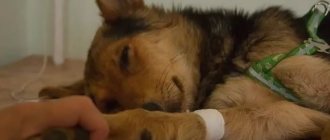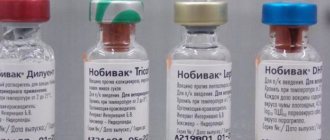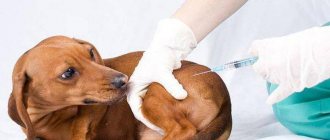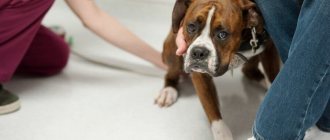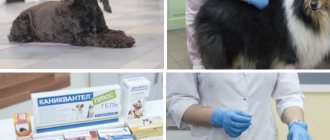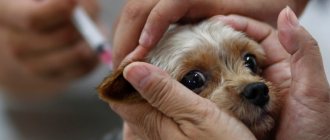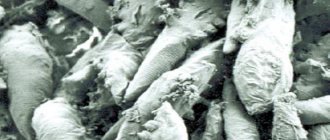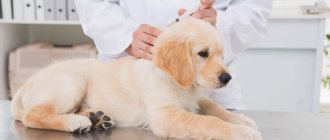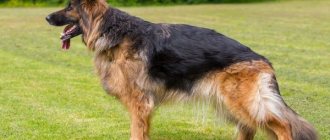COMPOSITION OF EURICANE AND FORM OF VACCINE FOR DOGS
The vaccine is an injection suspension mixed before administration from two components: lyophilized - "Eurican DHPPI2" and liquid - "Eurican-LR".
- Eurican DHPPI consists of culture liquids of cell cultures
infected with attenuated strains of canine distemper virus, adenovirus, parvovirus and canine parainfluenza virus with the addition of a drying medium as a stabilizer. Eurican-LR consists of inactivated leptospira serogroups L. icterohaemorrhagiae and L. canicola, glycoproteins of the rabies virus with the addition of aluminum hydroxide as an adjuvant. - The lyophilized component of the Eurikan vaccine in appearance is a dry, homogeneous, porous mass of beige color, the liquid component is a colorless liquid with a white precipitate that forms a homogeneous suspension when shaken. The components of the Eurikan DHPPI-LR vaccine are packaged in 1 vaccination dose (1 cm') in glass vials appropriate capacity, hermetically sealed with rubber stoppers reinforced with aluminum caps.
Reviews from veterinarians
Evgeniy, veterinarian with 6 years of experience:
“I think Eurikan is one of the best vaccines on the market. I have been using it in my practice for a long time, and all animals tolerate it well. There was never any drowsiness, apathy, or fever. The other day I vaccinated my two Yorkies. No negative consequences. After the injection, the pets remained as cheerful and active as before the vaccination.”
Galina, veterinarian with 10 years of experience:
“Eurican is an excellent vaccine. I have been using it in my practice for about 5 years. During this time, I never observed side effects such as drowsiness, anaphylactic shock, apathy, or fever, but there were three cases of enteritis after vaccination. One of the puppies almost died. But here it’s more about improper transportation than about the vaccine itself.”
PHARMACOLOGICAL PROPERTIES OF EURICANE
The Eurican DHPPL-LR vaccine causes the formation of an immune response in dogs against pathogens:
- plague
- hepatitis A
- parvovirus
- parainfluenza-2
- leptospirosis
- rabies
Immunity develops in vaccinated dogs 14 days after vaccination, lasting less than 12 months. One immune dose contains:
- Plague virus;
- Canine adenovirus (CAV2);
- Canine parvovirus;
- Canine parainfluenza virus type 2;
- Inactivated Leptospira icterohaemorrhagiae, Leptospira canicola, qs, to provide protection in accordance with the European Pharmacopoeia;
- Rabies virus glycoproteins.
The Eurikan vaccine for dogs is harmless and has no medicinal properties.
Why do dogs need to be vaccinated?
The condition of the dog, regardless of whether it is purebred or domestic, must be monitored by a veterinarian. This is due to the fact that in some cases the animal may encounter a variety of diseases, which can not only significantly affect its health, but also be life-threatening to the animal. Thus, despite possible complications after vaccination in dogs, it is imperative to carry out the prescribed vaccinations, after which dogs after vaccination, a dog after vaccination must be monitored by a veterinarian in order to maximally eliminate side effects of the drug or unforeseen consequences for the animal. If an animal has not been vaccinated at the right time, it can easily become infected with any infection or infect other healthy dogs.
In order for the animal to be healthy, certain vaccines have been developed today, the effect of which is quite simple to explain: a certain virus or a modified type of bacterium is introduced into the dog’s body in a strictly limited quantity. Consequently, after encountering a pathogen, the dog’s body, after vaccination, begins to independently produce the necessary antibodies, which are aimed at maximally adapting to the pathogen and, in the future, simply not reacting to it. Also, after vaccination, the animal may have a bump on the withers, which in itself is not dangerous for the animal.
As for the most common infections in animals that require mandatory immunization, they are mostly the following:
These conditions are among the most dangerous and require necessary vaccination. Thus, a dog must be vaccinated against rabies, and the reaction to the vaccine must be strictly monitored by a veterinarian.
DOSES AND METHOD OF APPLICATION OF EURIKAN VACCINE
When vaccinating, it is necessary to follow the rules of asepsis and antiseptics and use only sterile materials and instruments for injection.
Before vaccination, prepare a mixture by mixing the lyophilized vaccine "Eurican DHP-PI2" with the liquid vaccine "Eurican-LR", for which the liquid vaccine is drawn up with a sterile syringe, pierced with a needle, injected into the bottle with the lyophilized vaccine and shaken thoroughly. The dissolved vaccine must be used immediately.
The Eurikan DHPPI2-LR vaccine is administered in a dose of 1 ml (1 dose) subcutaneously in the scapula area or intramuscularly in the thigh area, regardless of the weight and breed of the dog, the vaccination program includes:
- 1st vaccination at 3 months of age
- Revaccination after a year.
Combinations with other vaccines of the Eurikan group are possible.
In unfavorable epizootic conditions, vaccination against leptospirosis is recommended once every six months.
Price
You can now view the current price of the drug and buy it right here:
The price of Eurikan depends on the type of vaccine:
- the cost of one dose of Eurican DHPPI2-LR (2 bottles) – from 400 to 480 rubles;
- the cost of one dose of Eurican DHPPI2-L is from 340 to 360 rubles.
And although the product can be ordered online, it is better to make the purchase at a clinic or the nearest veterinary pharmacy, since the vaccine can only be stored and transported at low temperatures.
Indications for active immunization of dogs using the Eurican vaccine
Eurican vaccine for dogs is used to prevent mortality and clinical signs caused by distemper virus, prevent mortality and clinical signs caused by infectious hepatitis, reduce viral shedding in respiratory diseases caused by adenovirus type 2, prevent mortality, clinical signs and viral excretion caused by parvovirus, reduce shedding of parainfluenza virus type 2, prevention of mortality, clinical signs, infection, bacterial excretion by the kidneys, nasal and kidney damage caused by Leptospira.
Owner reviews
Oksana, owner of a French bulldog:
“Previously, Nobivak was always used for immunization, but one day it was not available in the pharmacy. The pharmacist advised me to buy Eurican. This vaccine did not work for us. After the injection, the dog slept for almost a day. The nose was hot and dry, and she refused to eat. We went to the clinic and barely pumped it out. I will not use this product again."
Vladimir, spaniel owner:
“I have repeatedly used Eurikan to vaccinate my dog. My spaniel tolerates it well. There are no side effects. It protects well against dangerous viral infections; at least we were spared parainfluenza during the epidemic in the city. The main thing is to follow all the veterinarian’s recommendations and properly prepare the animal for the procedure.”
SCIENTIFIC REVIEW ON EURICANE VACCINE FOR DOGS
Eurican vaccine is a multivalent drug
, containing live viruses and inactivated bacterial antigens, which is indicated for the immunization of healthy puppies from seven weeks of age and adult dogs against distemper, adenoviral hepatitis, respiratory adenovirus, parvovirosis, parainfluenza and leptospirosis. The live viral components of the vaccine (canine distemper virus (CDV), canine adenovirus type 2 (CAV-2), canine parvovirus (CPV), canine parainfluenza virus (CPiV)) are presented in lyophilized form. The dilution bottle contains inactivated components (Leptospira Canicola, Leptospira Grippotyphosa and Leptospira Icterohaemorrhagiae) presented in liquid form.
Euricane is manufactured and controlled using proven methods and testing that ensure the consistency of products released to the market. Eurican has been shown to be safe to use in dogs. The product is safe for the user and the environment.
The most common reactions to vaccinations in dogs
As for the main reactions to a particular vaccine in a dog, it is worth noting that they can be very diverse, from the simplest to the most complex.
Common general reactions to vaccinations
As for these reactions, they mostly occur in a fairly large number of dogs and are the most common. For the most part, these are the following general reactions:
- compaction after vaccination, which is mostly noted at the injection site;
- a bump on the withers, a bump may be observed on the back at the site of vaccination;
- it happens that a characteristic allergic reaction may be observed at the injection site, which goes away on its own after some time;
- in some cases, some swelling forms after vaccination;
- after rabies vaccination the dog limps;
- after vaccination against rabies in dogs, the dog whines, trembles and becomes very lethargic;
- the animal limps for a certain period of time after vaccination (if the dog is completely lame, then you should immediately seek advice from a veterinarian);
- After vaccination, the animal may experience symptoms of ARVI or FLU (cough, fever or nasal discharge), the pet in this case does not feel very well;
- side effects of vaccination may include conditions such as allergies or vomiting;
- the animal may completely refuse food;
- the pet whines after vaccination;
- in some cases, the dog vomits, which can cause dehydration of the pet’s body;
- after vaccination, the pet may experience characteristic lethargy;
- a bump after vaccination at the site of its implementation;
- in some cases, infectious processes appeared at the injection site.
All general symptoms do not pose a threat to the pet’s health or life at all and may subside within one or two weeks. However, if any secondary infection does appear in the animal, then this condition in most cases can be eliminated exclusively with the help of antibacterial drugs.
One dose of suspension contains:
Active substances:
Inactivated Leptospira strains.
The vaccine is filled into type I glass containers
, closed with a chlorobutyl stopper and sealed with an aluminum cap. The choice of vaccine strains is justified by clinical trials. The inactivation process and detection limit of the inactivation control test are correctly confirmed.
The product is an established dosage form and its development is adequately described in accordance with the relevant European guidelines.
Learn about essential drugs in animals
- Vaccination of puppies
- Vaccination of domestic cats against rabies
- Vaccination of small animals
- Kitten vaccination
- Vaccination of dogs against rabies, distemper, parvovirus enteritis, leptospirosis, viral hepatitis and parainfluenza
- Why do kittens need to be vaccinated?
- Nobivac Triquet Trio
- Nobivac DHPPi for dogs
- Puppy's first vaccination and revaccination
- Comprehensive vaccinations for cats
- Tick vaccination for dogs
- What vaccinations are given to dogs and why?
- Why is Ursofalk prescribed to cats?
- Instructions for the use of serenia in animals
- Ursofalk in dogs
- Marfloxin for veterinary medicine
- Instructions for the use of serenia in dogs
- Instructions for using serenia in cats
- Why is Heptor prescribed to a dog?
- Instructions for the use of lidocaine in dogs
- Heptor in cats
- Lidocaine for cats. Can cats use lidocaine?
- Heptral in dogs
- Can cats use marfloxin?
- Marfloxin for dogs (instructions for use)
- Heptral in cats (instructions for use, pharmacology
- Instructions for use of Dirofen for cats
- Instructions for using Vetom in cats
- Instructions: multifel for cats
- Use of fosprenil in cats
^Top
At what age should you get vaccinated?
The timing of vaccination is also determined by the veterinarian, but, as a rule, doctors adhere to the general vaccination schedule for puppies under one year of age. The general vaccination schedule is as follows.
| Age | Vaccinations |
| 8–10 weeks. | The first vaccination against parvovirus enteritis, viral hepatitis and canine distemper. |
| 11–13 weeks (that is, three to four weeks after the initial vaccination). | The second vaccination against parvovirus enteritis, viral hepatitis and canine distemper. At the same time, the first rabies vaccination is given. If the risk of rabies infection is low (the dog lives in a kennel or in other conditions where contact with a rabies carrier is unlikely), then rabies vaccination is recommended at the age of 6 to 9 months. |
It is very important to correctly determine the time of the first vaccination. Puppies fed on mother's milk develop so-called passive (maternal) immunity. It exists due to antibodies to infectious diseases, which the bitch passes on to her offspring with milk, especially with its first portions - colostrum. If the mother is not vaccinated, then the children will not have passive immunity. Therefore, it is recommended to purchase puppies from responsible breeders who care about the health of the litter and vaccinate the producers in a timely manner. After all, any vaccination will provide protection to the puppy no earlier than two to three weeks later, and if maternal immunity is low, then during this period your pet runs the risk of contracting an infection.
If the litter is small and the mother has enough milk for one-month-old puppies, then the vaccination period is moved closer to 10 weeks. If the number of puppies under the bitch is large, and a lot of complementary food is already given per month, then vaccination is carried out at 6–8 weeks, provided the babies are in good health and development. For weak puppies from such a litter, it is recommended to postpone vaccination for 1–2 weeks.
It is not recommended to vaccinate puppies before two months of age. Firstly, maternal antibodies circulating in the puppy’s blood will interfere with the formation of a good response to the vaccine. And secondly, the immune system of the small organism itself is not yet fully formed and does not work at full strength. Still, in some cases it is necessary to vaccinate at the age of 4–6 weeks. Such a move may be justified, for example, if there is a threatening situation in the nursery due to a certain disease, and there is no maternal immunity to this infection. Then, when the puppy reaches 10–12 weeks of age, the vaccination is repeated, and then vaccinated again after three to four weeks. For early vaccination, there are specially developed preparations containing less aggressive antigens (PUPPY vaccine series).
People often ask when should a puppy have his first vaccination - before or after teeth change? Indeed, some vaccines can cause darkening of tooth enamel, so there is a practice among dog breeders to vaccinate growing pets either before the period of teeth change (up to three months) or after it, when the puppy is already six months old. The second option is dangerous because the dog may get sick, because the age of 4–5 months is the most problematic for diseases such as distemper or parvovirus enteritis.
